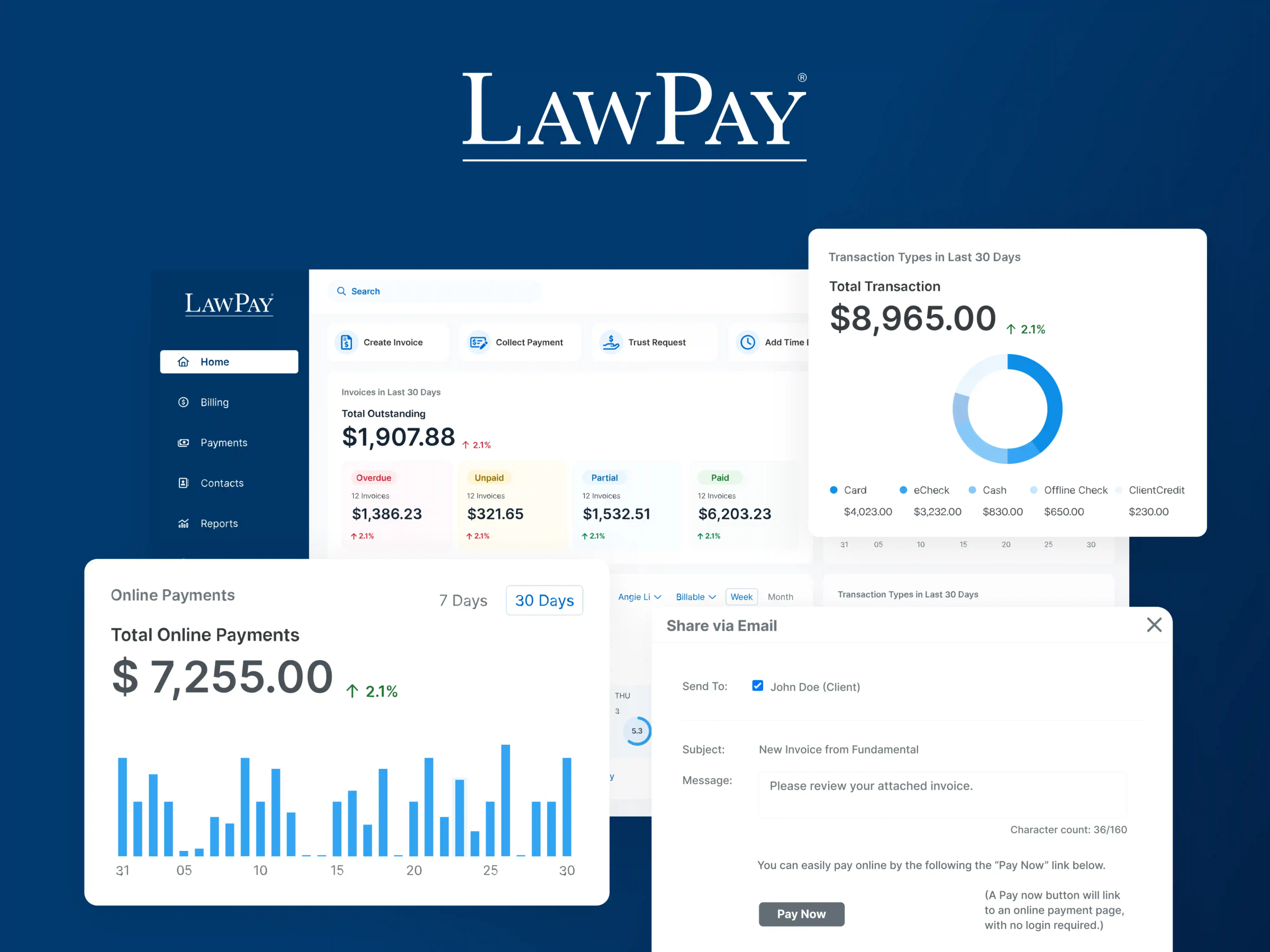The legal field is evolving. As the nature of an attorney’s job shifts, so do lawyer populations around the U.S. The modern lawyer must balance following secure data handling practices, contributing to a vibrant and diverse workplace culture, and providing excellent client service to stay ahead of the competition.
Monitoring industry stats can help you track where the legal industry stands. Read on for 21 must-know lawyer statistics across these five categories:
General statistics
Security statistics
Billing and payment statistics
Demographic statistics
Technology statistics
Schedule a demo to see what LawPay can offer your firm.
Get a demo
Why Is It Important To Stay Up To Date With Lawyer Statistics?
Whether you're a college student seeking a law degree, an attorney about to launch a new firm, or a seasoned pro working in a corporate law department, changes in the legal industry will affect your career. Staying current on facts about lawyers and law firms prepares you for job interviews, helps you network with colleagues, and supports informed decision-making in your practice.
Let's dive in.
Lawyer Statistics For 2024
The three general lawyer facts below cover how many lawyers are in the U.S. and lawyer population trends by state. You may find these helpful if you are finishing school and evaluating where you want to launch your legal career.
1. How Many Lawyers Are There in the U.S.?
The American Bar Association (ABA) reports about 1.33 million active attorneys in the U.S. Since 2019, this total has declined slightly from 1.35 million. Prior to the recent downward trend, the number of lawyers in the U.S. had increased annually since 1915.
2. Which U.S. State Has the Most Lawyers?
The state of New York has the highest population of active attorneys, at 187,246. California is a close second at 170,306. The remaining states in the top five for lawyer populations are Texas, Florida, and Illinois, according to the ABA.
3. Which U.S. States are Increasing and Decreasing Their Lawyer Populations?
From 2021 to 2022, the number of active attorneys in North Carolina increased by 6%. Nebraska showed the second-highest annual growth rate in this metric at 2.6%.
The ABA data shows that 21 states had shrinking lawyer populations between 2021 and 2022. The biggest decline was in Alabama, where the active attorney total dipped by 19.10%. Alaska and Ohio also reduced their active lawyer count by 9.5% and 9.2%, respectively.
Law Firm Security Statistics
If you're planning to launch your own firm, you'll need to understand the security landscape. The five stats below are a good starting point. They describe the prevalence, common causes, and consequences of security breaches. You'll also learn about incident response plans and the top security protection strategies.
4. How Many Law Firms Face Security Breaches?
In 2021, nearly one-third of law firms reported a security breach according to the ABA as quoted by the International Legal Technology Association (ILTA). More than a third of firms (36%) said their systems had been infiltrated by malware in the past.
5. What Is the Most Common Cause of Data Breaches at Law Firms?
A cybersecurity report from Verizon indicates that nearly three-quarters of data breaches result from accidental or intentional employee actions. An employee might get fooled by malicious links in a phishing email or accept a bribe from hackers in exchange for login information. The latter is far more likely to happen in large, high-profile firms.
6. What Are the Typical Consequences of Security Breaches?
According to Law Technology Today, the 2020 ABA Legal Technology Survey Report confirmed five common outcomes of a law firm security breach. Those outcomes are listed below, along with the percentage of legal practices reporting each:
Consulting fees for repair (39%)
Loss of billable hours (35%)
Temporary loss of network access (23%)
Temporary loss of website access (10%)
Replacement of hardware and/or software (17%)
7. How Many Law Firms Have Security Incident Response Plans?
The ABA technology report also concludes that only 34% of law firms have a cybersecurity incident response plan. An incident response plan is a documented set of procedures to guide the firm after a security breach. Having a plan in place can prevent unnecessary data loss, stem monetary losses, and expedite a return to normal operations.
Firm size is a determining factor in whether the business has a security response plan. Nearly 80% of firms with 100 or more attorneys have a plan, while only 14% of solo firms have one.
8. How Are Law Firms Protecting Their Systems from Security Breaches?
According to technology consultant AAG, most law firms have implemented various cybersecurity protective measures. The most used measures are listed below, along with the percentage of practices using them.
Spam filters (84%)
Software firewalls (79%)
Mandatory passwords (74%)
Anti-spyware solutions (73%)
Email virus scanning (72%)
File encryption and email encryption are also in use by 49% and 40% of firms, respectively.
Law firm managers should carefully analyze security features built into their tech solutions. As an example, LawPay’s payment solution relies on 256-bit military-grade encryption to ensure data security. The platform also enforces role-based permissions and password security protocols to control access to sensitive information.
Law Firm Billing and Payment Statistics
No list of lawyer facts is complete without a look into lawyer income and law firm billing and collection rates. These figures provide context on your income potential, whether you're seeking employment or running your own practice.
9.How Much Does the Average Lawyer Make?
According to the U.S. Bureau of Labor Statistics (BLS), the median annual salary for lawyers was $145,760 in 2023. That equates to an hourly rate of $70.08.
10. Which Type of Law Commands the Highest Hourly Rate?
Data from Statista shows that corporate law firms commanded the highest hourly rate in 2022, at nearly $350. Bankruptcy firms, on average, charged $343 hourly. Intellectual property lawyers are billed $342 hourly.
11. Which Firms Generate the Highest Revenue Per Lawyer?
In 2022, law firm Wachtell, Lipton, Rosen & Kratz reported $3.54 million in revenue per lawyer. Also in that year, Sullivan and Cromwell generated revenue of $2.14 million per lawyer, as published by Statista.
12. How Much Time Do Lawyers Spend on Nonbillable Work?
Legal receptionist service provider Nexa concludes that lawyers spend, on average, six hours daily on nonbillable work. One-third of those nonbillable hours go towards business development.
Streamlining nonbillable administrative tasks, then, is a primary goal of effective law firm management. Technology can help. Case management application MyCase, for example, automates client intake and delivers essential analytics to help you build administrative efficiency into your practice.
13. What is the Average Collection Rate for Lawyers?
Thomson Reuters reports that lawyers collect between 89% and 90% of what they bill. That collection rate has remained largely the same since 2013, after dropping from more than 94% in 2007.
Payment management applications, like LawPay, support higher collection rates by offering client-friendly digital payments and automated invoice reminders. Customers who use LawPay collect 33% more from their clients who paid using online payments.
Law Firm Demographic Statistics
These demographic statistics about lawyers cover gender, ethnicity, and age, plus a data point on the importance of workplace diversity to job seekers.
14. How Many Lawyers are Women?
According to the ABA, 39% of U.S. active attorneys are women in 2023. That percentage has increased from 34% in 2013. This data comes from 44 states that reported numbers on lawyer gender.
15. How Many Lawyers are African-American or Hispanic?
Another ABA stat indicates that in 26 reporting states in 2023, 5% of active attorneys are African-American and 6% are Hispanic. The percentage of African-American lawyers has remained flat since 2012, while the percentage of Hispanic lawyers has doubled since 2012.
16. How Many Lawyers are LGBT?
Online career platform Zippia reports that 10% of attorneys are part of the LGBT community.
17. What is the Average Age of Lawyers in the U.S.?
The average age of attorneys in the U.S. is 46.3, according to the same Zippia report. More than 67% of the U.S. attorney population is 40 years or older. Only 4% of the attorney population is 20 to 30 years old.
18. How Important is Workplace Diversity to Job Seekers?
According to AAG, 76% of job seekers believe workplace diversity is an important consideration in their search for employment. Nearly one-third of job seekers say they wouldn't apply to work for a company that doesn't have a diverse workforce.
Law Firm Technology Statistics
The following statistics about lawyers cover the most popular technology among law firms, how many firms use cloud-based solutions, and the top benefits technology brings to a practice.
19. What Is the Most Popular Law Firm Technology?
According to AAG, electronic billing is the most popular law firm technology. 48% of firms have implemented some form of billing software.
LawPay is the most popular software for legal billing and payments. Firms that use LawPay get paid faster and spend less time on administrative tasks. And, since LawPay is designed by lawyers for lawyers, payments are automatically handled in compliance with IOLTA and ABA guidelines.
20. How Many Law Firms Use the Cloud?
AAG also finds that 31% of law firms are using cloud-based solutions for document storage and automated workflows. Just 5% of law firms report being "uncomfortable" with cloud computing, down from 7% previously.
21. How Do Law Firms Benefit From Implementing Technology?
Nearly all (95%) of law firms agree that implementing technology has improved their ability to serve their clients' needs. Specifically, 84% of firms say technology has helped them reduce the delivery time of services.
Final Notes
Schedule a demo to see what LawPay can offer your firm.
Get a demo
Staying informed on the latest facts about the legal industry makes you a better lawyer. You'll have a deeper understanding of your role in the context of the industry, key challenges attorneys and law firms face, and potential solutions to those challenges.
Legal tech solutions, like MyCase and LawPay, can solve some of your practice's most pressing challenges. For billing and payment efficiency, schedule a LawPay demo today. For productive case management, sign up for a free MyCase trial.
About the author

Catherine BrockContent Writer
Catherine Brock is a Content Writer for leading legal software companies, including MyCase, Docketwise, CPACharge, CASEpeer, and LawPay—the #1 legal payment processor. She covers emerging legal technology, financial wellness for law firms, the latest industry trends, and more.
